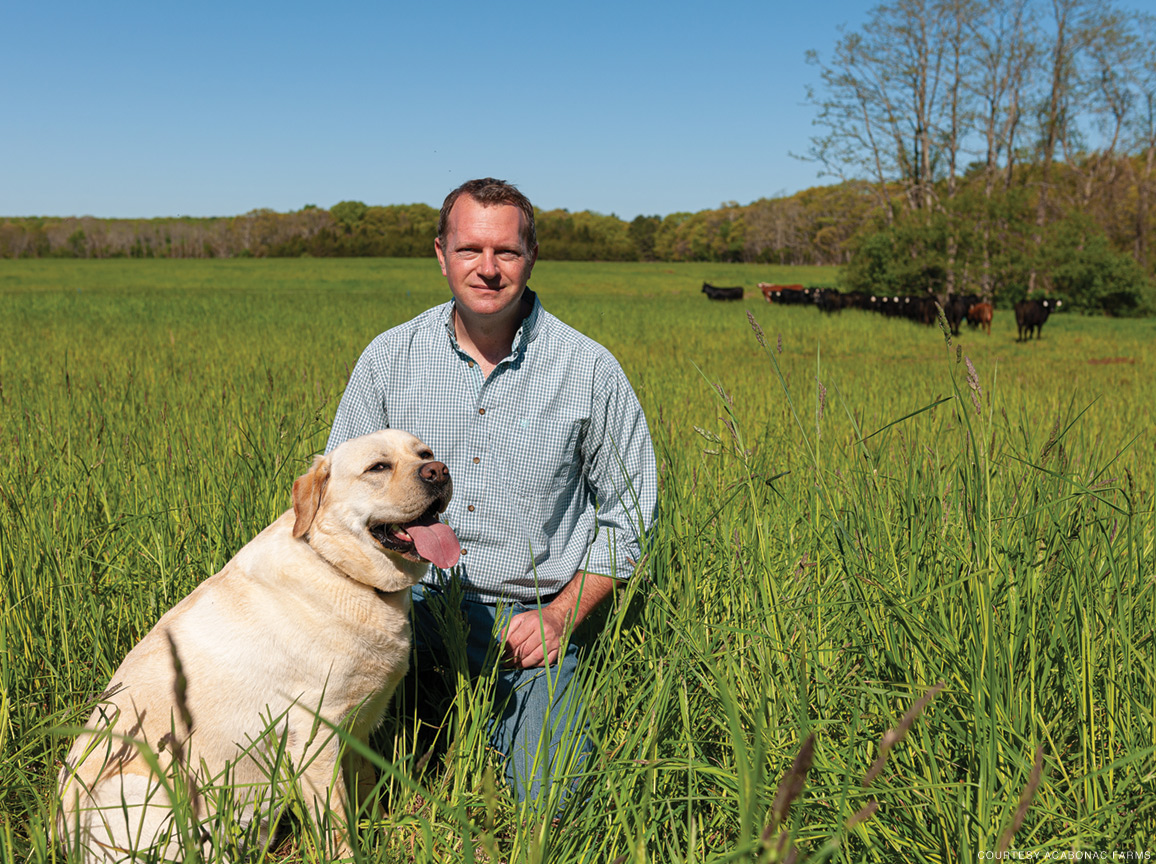
This Long Island regenerative farmer has found a new calling raising and selling pastured meats.
“If you’ve ever bitten into a locally grown tomato you’re like, ‘Whoa, I’ve never tasted something like that,’” says Stephen Skrenta WEv’97. “It’s the same with wine. What makes a Bordeaux or a wine from Tuscany or Napa so special? It’s the local soil and the environment.”
“It should be the same with meat,” he continues. “If you fatten an animal on local forages, grasses, and clover, what happens is that the meat takes on the flavor of the local community, just like a bottle of wine.”
In 2015 Skrenta left a career in finance to start Acabonac Farms, a company on Long Island that tries to do just that. He sells 100 percent grass-fed beef and pastured lamb, pork, and chicken.
Unlike other farms that use feedlots, where animals are confined in small areas and fattened up with corn and grain, Skrenta lets his animals roam freely and chow down on natural, nutritious grass. “We seed our fields with grasses that are high in energy, high in sugar. The animals then eat everything in sight, and then we move them to another area while we let that area recover,” he says. “It’s the way bison used to migrate across America. They eat everything in sight and move on. By the time they get back to the original spot the next year, everything would be regrown and healthy. The animal would not require antibiotics or to be supplemented with grain, and the land wouldn’t need to be fertilized.”
Skrenta does this work, called regenerative farming, on 300 acres on Eastern Long Island. He then ships his meat to individuals, farm stands, and restaurants in the Hamptons and New York. The business, he posits, is “better for human health, good for the environment, and supports local farmers” since he leases the land from them and makes their soil richer—and more valuable—by not using chemical fertilizers. “Most farmland in America is ploughed and tilled and filled with synthetic fertilizers, herbicide, and pesticides that cause soil to very quickly be functionally bankrupt,” he says. “We don’t plough, we don’t till, we keep the animals rotating on our property that deposit manure and urine and saliva and all sorts of good things into the soil.”
It’s a long way from the career he envisioned as a student.
Skrenta, who transferred to Wharton from James Madison University as an undergraduate, studied economics and finance. Needing a job to pay tuition, he approached the Philadelphia Stock Exchange, sitting outside “until someone asked me what I was doing,” he recalls. “I said that I needed a job, and the person said, ‘There is a fella who runs a clearing firm, which is a back-office function for traders, who is always looking for guys.’ I asked for his name and went up and knocked on the door.”
Skrenta was hired as a runner, collecting paper trades from the brokers, calculating them, and bringing them back to the trading floor. He worked between 7 a.m. and 3 p.m., before attending his Wharton classes in the late afternoon and evening. “I only graduated one semester late,” he says. “I loved the excitement.”
After graduating, he got a job in Chase Bank’s mergers and acquisitions group before moving to DLJ, which was soon acquired by Credit Suisse. A few years later he took a job at Blackstone, where he spent the rest of his finance career, eventually moving to London to help build an advisory business. “In finance you have to carve out your own little spot, you have to make the pie bigger,” says Skrenta, who spent 10 years abroad, traveling almost every day to meet clients.
By 2015 he had a wife and three children, and the family was ready to move back to the Northeast to be closer to family. “I asked my wife where she wanted to move, and she said she wanted to raise the kids on the beach,” Skrenta says. So they moved to Amagansett, a town in the Hamptons.
His plan to stay at home and help raise the kids didn’t last long. “It wasn’t that easy for my wife to deal with me all day,” he laughs. So he started searching for his next project.
Listening to Bloomberg Radio, Skrenta heard Chipotle’s then CEO Steve Ells attribute disappointing quarterly earnings to the company’s difficulties sourcing enough humanely and sustainably grown pork to satisfy demand. Surprised that a fast-casual restaurant chain “cared that much about their meat,” Skrenta did research and concluded that Americans were starting to pay more attention to what they put into their bodies. “People were also starting to think through the problems we had in the United States and the western world with obesity and heart disease and mental disease and what was going on with our air quality and water quality,” he says. “If you really dig into this stuff, it has to do with the way our food is grown, what we are eating.”
And so, Acabonac Farms was born. (Acabonac is an Algonquin word that means “root place.”)
Skrenta started by traveling to meet farmers in Ireland, Australia, New Zealand, and South Africa. He learned how more sustainable communities raised animals, fed them, and nourished their soil. He then convinced farmers on Long Island to lease land to “someone who knows nothing about agriculture,” he says. “But I have a gift for gab, so I convinced people.”
One of the biggest hurdles along the way has been hiring people. “If you are at Blackstone, and you are looking to hire one person, you get a few hundred thousand applications, and they are all 4.0 from Princeton and Harvard and Penn,” he quips. “If you are on Long Island, and you want to hire one great rancher, you have like zero people apply.”
In the early days, before he managed to employ three farmers (though it changes each season), he did most of the labor himself, including the “terrifying” experience of moving cattle. “These are thousand-pound animals,” he says. “If the animal doesn’t want to do what it doesn’t want to do, he isn’t going to do it.” But Skrenta learned tricks like positioning his body a certain way, snapping his fingers, and using voice tics to coax the animals into moving.
Acabonac Farms started by selling beef. In the last few years, chicken, lamb, pork, and even dog food have been added. “For every animal we get 10 pounds of filet mignon but around 300 pounds of ground beef,” he says. Since customers wanted more of the former than the latter, they started using the ground beef to sell as dog food.
The business is now one of the largest grass-fed animal operations in the Northeast. “We are slaughtering a few hundred cows a year and a few thousand birds,” he says. “It’s working with mother nature. It takes a little bit longer, but it is the way we are getting big and strong.”
—Alyson Krueger C’07

